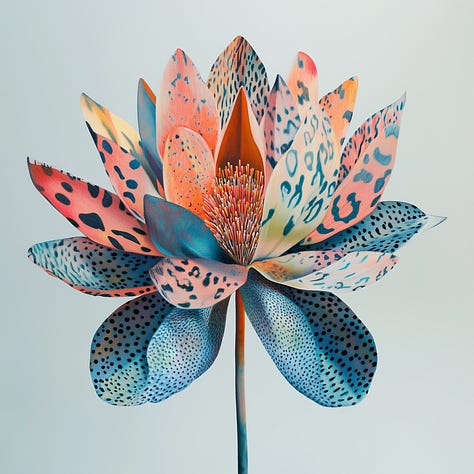What's ready to Bloom?
Unlearning to rely on pressure and control to achieve your creative goals
Have you felt strong pressure to make this year the year that you finally produce diamonds?
A diamond could mean anything. Starting a profitable business, landing a promotion, finding a partner, having kids, kicking off your career, taking that art project to the next level, etc.
Sometimes these wishes or goals are aligned with who you are and sometimes they aren't. But even when they are truly what you want, you may go about them with an enormous weight of expectations.
It’s like trying to turn coal into diamonds. Sheer pressure.
But what happens when you ease your grip on controlling the situation? What happens when you release expectations and surrender to what is unfolding?
In my case, my anxious part usually resists letting go.
If I really want something, this anxious part believes that only relentless hard work with tight timelines and a pressure cooker environment produces results.
But for some things in life, this is not only unhelpful, it's counterproductive.
Sometimes, you need to release your grip, ground yourself in your desires, and then, surrender. In this way, you allow yourself to bloom.
Flowers are not the same as diamonds. But in my view, they are equally beautiful.
So how might we expand with ease, like a blooming flower?



My invitation is to embody expansion, through the following 5 layers:
1. Experience - What feeling do you want to experience?
This could be something like the overall feeling in your body. It could also be how you want to feel emotionally, or mentally. It can even be how you want to feel on a spiritual, energetic, or existential level.
Example: This year I want to feel both aligned and alive. I want to feel deeply rooted within myself while also blooming outward, with effortless expression.
2. Express - What message or idea do you want to express?
This can be a big, world-changing idea, but it can be a small observation, a tiny footnote on an experience. Ultimately, when we create, we are hungry to share something: an idea, a feeling, a story. Sometimes, this message might only emerge during the creative process or after we make the thing. But often enough it helps to know what we're trying to say before we say it.
Example: One core message I'm ready to express is the idea that a personal creative practice is like exercise for the soul. And similarly to doing sports and fitness, creativity also functions as a boost to our health and wellbeing. We don't need to be full-time professional artists either (although we can be) to benefit from living a creative life.
3. Execute - What do you want to execute to bring your idea to life?
This is what most people jump to when they think about dreams and goals. They focus on the actual thing they want to build. It helps to name the thing, be that to make a movie, write a book, or start a business. But I'm convinced that the first two layers of knowing how you want to feel and what you want to express come first. After those two are clear, we can focus on the container, or channel for our expression.
Example: One of the ways I want to execute to bring my message to life is to write this newsletter. The other one is to speak on stages, both virtually and in-person. Thirdly, I want to grow my coaching and training practice helping creatives to tap into their creativity and birth their best work. These are things I’m excited about executing this year, but I could have chosen other things, like writing a book, making a documentary or building an app.
4. Explore - What skill or experience do you want to explore that will help you execute on your vision?
Regardless of what you want to execute, there are probably a few things you might want to learn or experience to support your journey. But out of the many, many things you could explore, there are probably a couple that would make the biggest difference. It's a good idea to focus on exploring what will both support you and fuel your excitement.
Example: Let’s zoom in on my wish to share my message in stages. For this, I want to gain more experience and deepen my skills in public speaking. There are many things I could do to explore this, but I’m not sure which might yield the biggest impact. This leads to the next point, which is experimentation.
5. Experiment - What small step or experiment do you want to try?
Breaking down your visions and skill investments into a tiny experiment helps you reduce the overall barrier to get started. It also helps to choose a path more easily since the commitment is low, and let go of any actions that don't feel aligned or helpful. By running small, low-stakes experiments, you can reduce the amount of energy and time it takes to pivot toward a better approach.
Example: In my exploration of public speaking skills, I could run an experiment to attend Toastmasters for 1 month. I could also experiment with spending 30 minutes every day researching and pitching myself for speaking opportunities for 2 weeks. Lastly, I could experiment with recording my newsletter in an audio format to experiment with a low-stakes / low-effort podcast for 2 months.
Last considerations:
Play with the time horizon of your experiment. You can also extend or reduce the time commitment to make it as easy as possible to follow through.
Connect your experiment with your experience. Before committing to an experiment, you can evaluate how likely it will support your desired feeling (layer 1). Ultimately, you want to connect my doing to your being.
It’s worth remembering that buds bloom continuously in tiny, gradual imperceivable movements. But when the timing is right, you suddenly have a flower.



Your Creative Year
Want to keep reflecting on these layers of expansion and make them really your own? We’ll be continuing this discussion live in my upcoming workshop “Your Creative Year” happening this Thursday, Jan 16th.
It's free and open for anyone who wants to prioritize their creativity this year.
Register here.
That’s it for now!
Thank you for being here - it means the world!
With love,
Paula




